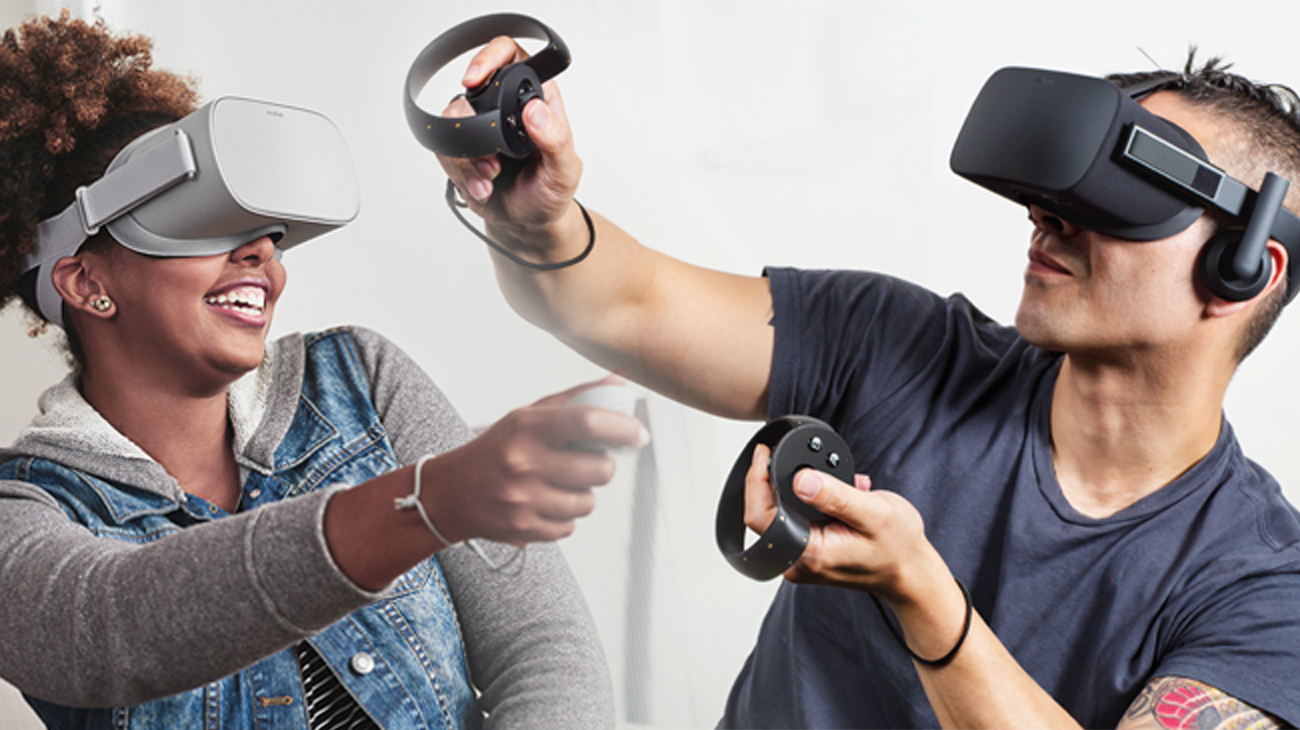Virtual reality 101: a beginner’s guide to getting into VR games, movies and apps

It can be hard to catch up with a technology once it’s picked up steam. It seems like everyone knows every little detail about it and, if you can’t find a welcoming community, learning the ropes can be almost impossible.
For some folks, that’s what happened with virtual reality. A technology that went from silly retro tech to developer kit to full-blown cultural phenomenon overnight.
If you missed the first four years of VR’s rise to prominence, don’t worry. The technology is less complicated than you think and is super easy to understand. There’s affordable ways to try it before you buy it, and plenty of ways to find new content if you’ve already bought a headset.
Not sure where to start in this wondrous world on the edge of the digital and physical spaces? Let us be your virtual tour guides as we take you step-by-step through the technology.
What is virtual reality? How is it different from a computer or a TV?
When we talk about virtual reality, we’re talking about images, videos, games or software that offers a 180-degree or 360-degree field of view. It’s content that you can explore or experience first-hand, getting closer than ever before.
When most folks think about VR, their first thoughts are of 3D – the display technology that used stereoscopy to give the illusion that images were popping out of the screen. VR is similar in that it sometimes uses tricks to add realism to content, but it doesn’t stop where the screen stops – it fills your entire field of view with an image or environment.
Instead of looking at a shark on Discovery Channel, there are apps that put you in a shark cage and allow you to experience what it’d be like to see the animals swimming around you.
Why people like it so much is because the content feels more immersive. Instead of looking at a shark on Discovery Channel, there are apps that put you in a shark cage and allow you to experience what it’d be like to see the animals swimming around you. It’s the first step towards the holodeck that you saw on Star Trek 40 years ago.
Sign up for breaking news, reviews, opinion, top tech deals, and more.
Now, obviously, not every video or videogame ever made is available in VR – at least not natively. VR works best when the content is produced for virtual reality and is viewed on a virtual reality headset… even a cheap one like the Google Cardboard.
The quality of this content varies wildly – just like every YouTube video isn’t an Oscar-award winning production – but the central idea behind it all is that it’s more immersive than 2D.

Is VR healthy? Can you get hurt while using it?
The general consensus is that yes, it’s totally safe to use, especially for adults whose eyes have already stopped developing and who don't really get motion sick. Whether it’s safe for kids ages 13 and under remains a subject of debate, but most companies recommend limited use for the age group with plenty of breaks.
In fact, even for adults just getting into the medium, we recommend slowly getting acclimated. Putting the headset on for a few minutes at a time then taking it off, just to get your eyes used to having a screen that close.
Wearing a headset for an hour or more does put some strain on your eyes and it can cause headaches if you’re not properly hydrated or motion sickness if the content you’re watching moves in a way that feels unnatural to your body.
That said, eye fatigue is probably the most ‘dangerous’ part of VR. Wearing a headset for an hour or more does put some strain on your eyes and it can cause headaches if you’re not properly hydrated or motion sickness if the content you’re watching moves in a way that feels unnatural to your body. Neither is permanent, though, and both should subside fairly quickly once you take the headset off.
Just as important as taking breaks is clearing the space around you while using a VR headset – unless you’re using the passthrough cameras on the headset, there’s no way to see what’s going on around you so it’s incredibly easy to trip and fall if you’re playing in a furnished room. Most PC headsets will ask you to setup boundaries before you start playing that will prevent you from walking into anything but usually the more empty the playspace is, the safer it’s going to be for you.

What’s the difference between the headsets? Do you need one?
When we talk about headsets, they usually fall into three categories: PC-tethered headsets like the Oculus Rift and Valve Index, mobile-powered headsets like the Samsung Gear VR and standalone headsets like the Oculus Quest. There's also one console-based VR headset called PlayStation VR that plugs right into your PS4.
PC-tethered headsets usually look the best, feel the most immersive and offer the greatest range of experiences. They’re also typically the most expensive, too. They work by plugging the headset into the USB and DisplayPort/HDMI ports on your computer and installing specific software like SteamVR or the Oculus app. Most often they come with specific controllers and tracking stations, but that’s not always the case and each headset is different.
Mobile-powered headsets were the first to market and gained popularity when Samsung gave them away with the purchase of a new phone back in 2017. They work, as you’d expect, by slotting your phone into the headset and strapping it to your face. The experiences on this platform aren’t as immersive or as good-looking as the ones you’d find on PC-tethered headsets, but they’re a good starting point if you’re not sure about VR.
Last but not least, there’s standalone headsets that build everything you need into the headset itself so you can basically unbox it and be ready to play in minutes. We like these because they offer a happy medium between price and performance, and offer almost all of the same experiences you’d find on PC-tethered headsets. Heck, Oculus even gives you the option of plugging the Quest into your PC via the Oculus Connect Cable – so it’s the most flexible option as well.
Once you’ve decided on what type of headset you want, it’s worth looking at the specific specs each headset offers. You should compare resolutions (how many pixels are on the screen), field of views (how much you can see at once), frame rates (how smooth content is) and how the headset is tracked, either with discrete base stations or via built-in cameras.
So do you need a headset at all? Well, if you want the full experience, yes. But if you just want to watch VR videos to see what you’re missing, YouTube, Facebook and many other sites have the option to view 360-degree videos on your mobile phone and PC. This can be a good first step into the world of VR without plunking any money down.

What type of content is out there?
Not sure where to start? Check out our lists of the best VR games, best PSVR games and best VR headsets.
This question is sort of like asking “what type of content is out there on the internet?” The answer is, well, lots of things! The vast majority of the time, though, you’ll use a VR headset to watch VR videos like 360-degree concerts or art installations or roller coaster rides as well as play VR games from Oculus and Steam.
If you’re an enterprise user or you need a VR headset for work, you might use it to hold virtual meetings where you bring in 3D assets for everyone to look at or use the headset for specific training simulations. Educators might use it to bring their lessons to life for their students via interactive experiences, and you might even try a headset on inside amusement parks as more begin to adopt VR as a new form of entertainment.
The pool of content is as wide and deep as you’d expect it to be. There’s a lot out there, and there’s no way to see everything in one day.
The pool of content is as wide and deep as you’d expect it to be. There’s a lot out there, and there’s no way to see everything in one day.
So how much does this content cost? Well, it varies. Lots of these YouTube and Facebook videos are free, as are the apps like Gizmo and Oculus Video that you use to view them. There are also a number of free demos of VR games that are available to try, and a number of free VR educational apps. You can get reasonably far without every spending a dime.
That said, premium content like AAA games or longer VR experiences do cost money, from $10/£10 all the way up to $60/£60.
The good news is that there are a number of subscription services out there like Viveport Infinity that allow you to download a number of these games for one monthly fee and many of the online stores where you buy games and experiences often hold sales with massive discounts on the most popular content.
Should you buy a VR headset?
Hopefully by now you can answer this one yourself. If you’re the kind of person who likes to be on the cutting edge of technology and who has the time to dabble in new experiences, then yeah, it’s totally worth diving into VR. But if you’re strapped on time and money, and you’re not sure VR is right for you, watch a few VR videos on your phone to get a preview of the experience or buy a cheap VR headset that you won’t feel bad if it sits on the shelf.
Personally, we use our VR headsets once a week – typically to try the latest marquee game that’s available in VR or catch up on cool new videos. Some people use it everyday as their primary way to play games, while some might use it a lot less. It all depends on you, your schedule and your interest in the platform.
But hopefully now you have a better idea of what to expect from VR and how it’s different.

Nick Pino is Managing Editor, TV and AV for TechRadar's sister site, Tom's Guide. Previously, he was the Senior Editor of Home Entertainment at TechRadar, covering TVs, headphones, speakers, video games, VR and streaming devices. He's also written for GamesRadar+, Official Xbox Magazine, PC Gamer and other outlets over the last decade, and he has a degree in computer science he's not using if anyone wants it.